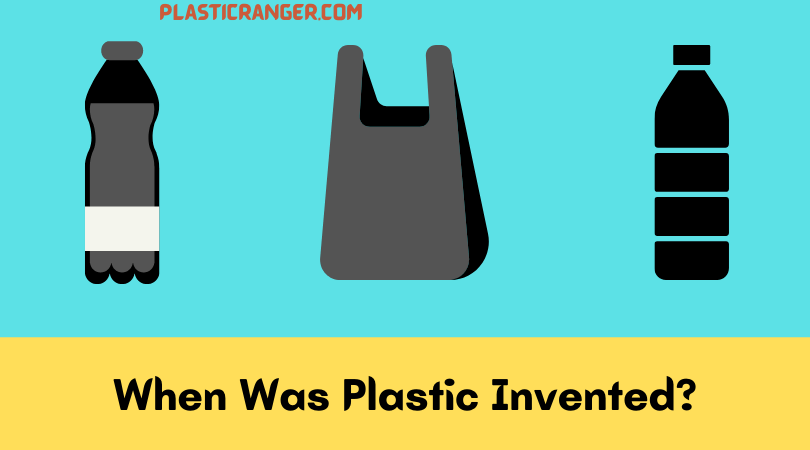The invention of plastic has transformed our lives to make it fast, reliable, and, better or worse, more disposable. Let’s find out more about the exciting history of plastics.
When Was Plastic Invented? | The History of Plastics
Belgian chemist and clever marketeer Leo Baekeland developed the first fully synthetic plastic in 1907. He defeated his Scottish rival, James Swinburne, to the patent office by one day. His invention, which he would name Bakelite, blended two chemicals, formaldehyde, and phenol, under heat and pressure.
Plastics have a long history. The invention of plastics has changed the world for the better and made it what it is today. It was 1862 when Alexender Parkes introduced the first-ever man-made plastic at the London International Exhibition.
It was named “Parkesine,” and Parkes discovered it when trying to invent a synthetic alternative for shellac for waterproofing. Parkesine was marketed as a better working substitute for ivory and horn.
For better or worse, Parkesine was not a commercial success but was crucial in developing the first artificial plastic. Then, another breakthrough came along. The potential value of the material was realized when an inventor named Wesley Hyatt in Albany, New York, discovered a technique to develop and manufacture an enhanced version of Parkesine, now popularly known as Celluloid.
Another major event in the world of plastics was when Polyvinyl Chloride (PVC) was first polymerized between 1838-1872.
However, the most crucial breakthrough came in 1907, when Belgian-American chemist Leo Baekeland created Bakelite, the first synthetic, mass-produced plastic.
The question of when plastic was invented must still be spinning in your mind. And that’s okay, as the question doesn’t have a short and simple answer. It’s a long tale with lots of things happening in it.
Since the creation of Bakelite, the stream of plastic engineering, research, and development has jumped leaps and bounds, offering a wide range of properties and applications to work with. It’s so ingrained in our lives that whatever you see around you right now, I mean right now, there are good chances that most things are made from plastic.
Now, I can neither see the future nor predict it. However, it’s safe to say that plastics will always have a crucial role in our lives for eternity.
Here’s my take on the history of plastics and when was plastic created with a brief mention of all the major events.
The Earliest – Horn, Macintosh, Hyatt Brothers, and More…
1284- The year with the first recorded mention of The Horners Company of London, horn and tortoiseshell being used as the prime natural plastic.
1820s – Vulcanised Rubber, Gutta Percha, Parkesine, Cellulose.
1823 – Macintosh uses rubber gum to waterproof cotton, and the ‘mac’ is born.
1845 – Bewley designs and manufactures extruders for gutta-percha.
1850 – First submarine telegraph cable in gutta-percha was put down between Dover and Calais.
1862 – Introduction of Parkesine, and the successor Celluloid, at the 1862 Great International Exhibition in London.
1872 – Hyatt brothers patented the first plastics injection molding machine technology.
1880 – Fashion for long hair among both women and men boosted the demand for combs made from celluloid replacing horns, and it became the preferred
1885 – George Eastman Kodak patents the first machine to produce a continuous photographic film based on celluloid.
1890 – Thermoforming got introduced and became mainstream, making babies rattles from celluloid.
1892 – Viscose silk aks rayon developed by Cross and Bevan.
1898 – The beginning of bulk-production of rpm gramophone records for shellac.
1899 – Krische and Spittler in Germany awarded a patent for Casein Plastic from milk. Artifacts were displayed at the Plastics Universal Exhibition in the year 1900.
Interesting Read – Top 10 Injection Molding Machine Manufacturers in China
1900-1929: Early Synthetics, Bakelite, Ureas, and More…
1909 – Casein plastics were derived from milk and were developed by Erinoid.
1910 – Stockings made from Viscose started manufacturing in Germany.
1915 – Queen mary spots Casein products at the British industries fair and orders various pieces of jewelry made from it.
1916 – Rolls Royce started using phenol-formaldehyde in its car interiors.
1919 – Eichengrun produces the first cellulose acetate molding powder.
1921 – Beginning of fast growth of phenolic moldings, especially for electrical insulation – Phenolic lamination will become mainstream by 1930.
1922 – Standuinger published his research that plastics are made from long chains of molecules and won the noble prize for his study in 1935.
1924 – Rossiter at British Cyanide develops urea thiourea formaldehyde resins, patented and commercialized as the first water-white transparent thermosetting molding powder.
1926 – Harrods hosts the first display of new colored thermosetting plastic tableware produced by Brookes and Adams, manufactured by Brookes and Adams, The Streetly Manufacturing Company, and Thomas De La Rue and Co. In addition, Eckert and Ziegler patented the first commercial modern plastics injection molding machine.
1929 – Bakelite Ltd. received its most significant order ever for phenolic molding powder for the casing of the Siemens telephone.
Fascinating Read – How is Plastic made? A Simple and Detailed Explanation.
The 1930s: Plastics as a Full-Fledged Industry and More…
1930 – ‘Scotch tape’ was the first transparent sticky tape invented by 3M Company in the US.
1932 – Screw per plasticization in injection molding got patented.
1933 – Fawcett and Gibson at ICI discover polyethylene.
1933 – Crawford at ICI develops the first commercial synthesis of polymethyl methacrylate.
1935 – Troester in Germany produced the first extruder made from thermoplastics.
1935 – Nylon was patented by Cathrore and Dupont.
1936 – First production batch of aircraft canopies made from ‘Perspex.’
1937 – Colombo and Pasquetti in Italy manufacture the first screw extruder machine.
1937 – Commerisilication of polystyrene by IG Farben, Germany.
1938 – Full-scale production of Nylon 6 Fibre in the United States.
1938 – The first toothbrush was made from Nylon tufts is manufactured.
1938 – Dupont discovers PTFE.
1939 – Commercial production of polyethylene was started in the UK by ICI.
1939 – Outbreak of war, strategic stockpiles, and plastics in war.
The 1940s: Plastics in War

1940 – Use of polyethylene in Radar. The first production of PVC in the UK. DuPont introduces polyacrylonitrile (PAN).
1941 – Whinfield and Dickson, the Calico Printer’s Association of Manchester, patented “polyethylene terephthalate” (PET); following was the creation of the first polyester fiber called Terylene.
1942 – ‘Dr. Harry Coover and Eastman Kodak first discovered Super Glue’ (methyl cyanoacrylate).
1943 – The inauguration of a pilot plant for PTFE; was marketed under the trade name ‘Teflon.’
1945 – The production of LDPE led to Monsanto’s mass production of the Sqezy bottle, causing a staggering industry growth, with containers made to replace glass bottles and containers.
1947 – Decotatoive laminates with Formica melamine were introduced in the UK.
1948 – Acrylonitrile-butadiene-styrene (ABS) production started.
1948 – George deMestral invents Velcro and gets a patent in 1955.
1948 – Introduction of 12” long-playing records made from polyvinyl chloride (PVC).
1949 – Development of the first Airfix self-assembly model made initially from cellulose acetate and later polystyrene.
1949 – High impact polystyrene was introduced as commercial plastic.
1949 – Tupperware, a company that was going to revolutionize the plastic goods market in the future, was launched in the US.
1949 – ‘Lycra’ based on polyurethane, was invented and branded by Dupont.
Engaging Read – 7 Types of Plastics | An Helpful Illustrated Guide
The 1950s: Fashion, Textiles, Toys, and More…

The 1950s – The polyethylene bag made its debut. The introduction of ABS (Acrylonitrile-butadiene-styrene) polymers. ICI opened an inaugurated factory at Redcar to produce Terylene.
1951 – Festival of Britain – a national exhibition and fair that reached millions of visitors throughout the United Kingdom in the summer of that year.
1953 – The commercialization of fibers introduces the concept of ‘drip dry’ and ‘non-iron.’
1954 – Dow Chemical Ltd introduced polystyrene foam.
1955 – The production started for HDPE (High-Density-Polyethylene) began in the UK.
1956 – Reliant Regal 111, the first commercially successful all-glass-reinforced-plastic bodied car, goes on sale.
1956 – Eero Saarinen launches a Tulip chair consisting of a seat made of glass-fiber-reinforced plastic.
1956 – Dupont files and receives the first acetals (POM) patents.
1957 – The hoop was re-invented as a Hula hoop by Knerr & Medlin, Wham-O Toy Company.
1957 – Pilot production of Polypropylene by Montecatini utilizing Ziegler-Natta catalysts.
1958 – Pilot production of Polycarbonate by the company Bayer and General Electric.
1958 – Lego patents its stud and block couplings system and produces toys of cellulose acetate, which later transitions to ABS.
1959 – Mattel uncovered the barbie doll at American International Toy Fair.
The 1960s and 70s: Design, color, and Moon Landing

The early 1960s – Introduction of water-based plastics.
1960 – Dupont launches Ethylene-vinyl acetate copolymers.
1962 – Dupont launches Polyamide films and varnishes.
1962 – Silicone gel-based implants have become mainstream.
1965 – Dupont developed Kevlar®.
1966 – Introduction of fuel tanks made from Blow Molding.
1967 – Polyvinyl chloride ‘Blow’ chair was introduced and designed by Scolari, De Pas, and Lomazzifor and manufactured by Znaotta.
1969 – Neil Armstrong stations a Nylon flag on the moon.
1970 – British Gas introduced the UK’s first yellow HDPE pressure pipes.
1973 – PET Beverage bottles were introduced.
1976 – plastics in various forms officially become the most used material in the world.
1977 – ICI introduced Polyaryletheretherketone (PEEK).
1979 – First commercial mobile/portable phones were introduced.
1979 – Installation of first double glazed windows.
1980s & 90s: High-Performance Plastics Made Everything Possible

1980 – Pilot production of (Linear low-density Polyethylene)
1980 – Introduction of Blue HDPE pressure pipes for potable water in the UK.
1982 – First manufactured heart made from polyurethane was implanted in a human.
1983 – ICI and Bayer introduce PEEK, PPS (polyphenyene sulphide), and PES (polyether sulphone).
1987 – BASF, a German company, develops a polyacetylene with twice the copper’s electrical conductivity.
1988 – Introduction of the triangle-shaped symbol representing plastics.
1989 – The University of Cambridge, UK, saw the first light-emitting polymers.
1989 – The Gravimetric Batch Blender was invented by Steve Maguire, reforming the industry and bringing affordable gravimetric blending machines to processors.
1990 – ICI launches Biopol, the first commercially available biodegradable plastic.
1991 – Dyson’s Vaccum cleaner was launched in Japan.
1994 – Smart cars with lightweight, colored, and flexible polycarbonate panels were introduced.
1998 – Freestanding Zanussi Oz fridge, making it the first of its kind product to have insulation and outer skins made in one process from polyurethane foam introduced.
2000-2010: Nano Technology, iPod, Airbus A380
The 2000s – Nano-technology became the new norm for the manufacturing industry, which also affected the plastic sector in a significant way.
2000 – First commercial metallocene-catalyzed polyolefins introduced.
2001 – Tony Fidell conceptualized iPod, an independent inventor developed by Apple Inc.
2005 – NASA explored the advantages of polyethylene-based material called RFX1, which could be used in a spaceship to take astronauts to Mars.
2005 – Polycond project is launched to research the potential of conductive polymers.
2008 – Airbus 380, comprising 22% carbon fiber reinforced plastics, flies into Heathrow.
2008 – Boeing 787 (nickname – ‘Boeing’s Plastic Dream’) starts operations; the outer layer is made from 100 % plastic composites, and plastic makes up 50% of all materials in the plane.
Interesting Read – What is TPE Material? | The Definitive Guide
2010+: Plastic is the Future
Plastics Blood: Developed by the University of Sheffield to imitate hemoglobin for use for trauma patients where blood is needed on an emergency basis.
Bullet-Proof Polymer: Scientists at Rice University, Texas, have developed a super polymer that can stop a 9mm bullet and seal the hole behind it.
Implantable Polymers: Medical grade and implantable biomaterials such as PEEK will be utilized in neurological applications to help control Parkinson’s disease, brain trauma, and epilepsy.
Plastic Solar Cells: A polymer solar that will work by utilizing sunlight by the photovoltaic effect provides a better and improved version of the traditional solar panels. It will be lightweight, inexpensive, and disposable.
Commercial: Space flights made from lightweight carbon composite materials will be essential in developing sub-orbital tourist spaceflights.
Flexible Plastic Screens: LEDs are placed on plastic foils to create electronic devices with flexible displays.
3D printed: Plastic material like PMMA or acrylic will help make body parts at home, and doctors can design replica kidneys and livers for transplant patients.
Polyvinyl Chloride (PVC) is the most widely produced synthetic polymer, with more than 40 million tons of annual production worldwide. It is one of the essential polymers contributing to plastic engineering & technology development. So it’s obvious I will go through its history too.
The Story of Polyvinyl Chloride (PVC): 100 Years of Dominance

1913: German Inventor Friedrich Klatte patented a polymerization technique to manufacture PVC.
1926: Waldo Semin, from BF Goodrich in the US, invented plasticized PVC to replace increasingly expensive natural rubber.
1930: RCA Victor launched the first commercially available vinyl long-playing record.
1947: The first vinyl floor covering was manufactured by the Swedish company Limhams.
1950: PVC blood bags successfully replaced glass bottles, making transporting blood much safer.
1966: Development of vinyl wall covering for supreme interior hygiene.
1979: First PVC-U double glazed windows became mainstream in the UK.
2000: European PVC industry was established inly2010, ten years committed to improving the environmental efficiency of PVC.
2003: Recoviyl, a sustainable European PC recycling system, was established.
2004: First windows were made from 100% post-usage PVC.
2012: Over 142,00m2 PVC fabrics were used to construct the London Olympic venues.
Engaging Read – What is a Plastic Mold? | Parts of Plastic Mold | Applications of Plastic Mold
The Future of Plastics
Given the environmental challenges that plastic waste poses, the future of this versatile material has become an increasingly important and concerning the topic. Fortunately, there is hope for the future of plastic through innovations such as biodegradable plastic and plant-based materials like PLA.
One area of promise is the development of biodegradable plastics, which naturally break down in the environment, lessening the accumulation of plastic waste in landfills and oceans. These plastics are often made from renewable sources such as sugarcane, corn starch, and cellulose, rather than nonrenewable fossil fuels.
Researchers are also exploring the use of plant-based materials as an alternative to traditional plastics. For example, algae and other sustainable resources are being investigated as a source of biodegradable materials.
In addition, efforts are being made to increase the recyclability of plastic and promote waste reduction strategies, such as the use of reusable materials.
Ultimately, the future of plastic will depend on a combination of technological advancements and a shift in consumer behavior toward sustainable practices. Although there is still much work to be done in addressing the environmental impact of plastic waste, biodegradable plastics, and plant-based materials offer hope for a more sustainable future.
FAQs
Below are the frequently asked questions on when was plastic made. Let’s dig deep to know more.
Why did we start using plastics?
Plastic became mainstream as it can protect the natural world from the destructive forces of human needs. Creating new materials, including plastics, helped free people from the economic and social constraints created by the scarcity of natural resources. Affordable celluloid made material wealth more accessible and widespread.
What are the 7 seven types of plastics?
The most common types of plastics are as follows;
- Polyethylene Terephthalate (PET or PETE)
- High-Density Polyethylene (HDPE)
- Polyvinyl Chloride (PVC or Vinyl)
- Low-Density Polyethylene (LDPE)
- Polypropylene (PP)
- Polystyrene(PS or Styrofoam)
- Other (ABS, Bioplastics).
What are the two main types of plastics?
The two main types of plastics are Thermoplastics and Thermosets.
Which is the toughest plastic material in the world?
Polycarbonate is the toughest plastic in terms of impact strength. It is 200 times more potent than glass and is thus extensively utilized in bulletproof windshields and windows.
What are the general properties of Plastics?
The most distinctive properties of plastics are low-cost, durability, strength, lightweight, processability, electrical and chemical insulation, and shock, corrosion, water, and heat resistance.
Suggested Read
- 6 Best Plastic Molding Techniques | A Complete Analysis
- What are PVC Pipe Sizes? | What are PVC Pipe Dimensions? | The Complete Guide
- What is the Glass Transition Temperature of Plastics?
- What is Modulus of Elasticity Units | The Ultimate Guide
- How to Choose the Right Lubricants For Plastic Parts?
- Flow Rate of PVC Pipes for Schedule 40 and 80
The Conclusion
In conclusion, the invention of plastic marks a significant milestone in the history of human civilization. From humble beginnings as a substitute for ivory, the development of plastic has revolutionized various industries, from packaging and construction to electronics and healthcare. While the creation of plastic has brought numerous benefits, it has also posed significant environmental challenges, with plastic waste polluting our oceans and ecosystems.
Today, efforts are underway to reduce plastic consumption and promote sustainable alternatives, such as bioplastics and reusable materials. The history of plastic serves as a reminder of the importance of responsible innovation and the need to balance technological progress with environmental stewardship.
Kindly share your thought and reviews in the comment box.
Have a fantastic day.
Quick Navigation

